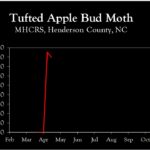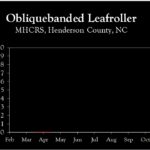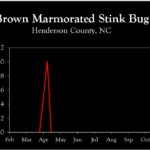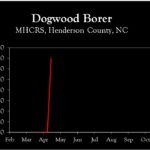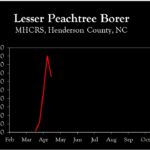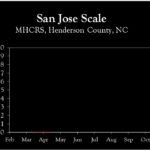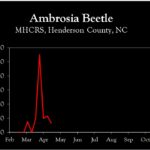WNC Orchard Insect Pest Populations – May 10, 2022
go.ncsu.edu/readext?863938
en Español / em Português
El inglés es el idioma de control de esta página. En la medida en que haya algún conflicto entre la traducción al inglés y la traducción, el inglés prevalece.
Al hacer clic en el enlace de traducción se activa un servicio de traducción gratuito para convertir la página al español. Al igual que con cualquier traducción por Internet, la conversión no es sensible al contexto y puede que no traduzca el texto en su significado original. NC State Extension no garantiza la exactitud del texto traducido. Por favor, tenga en cuenta que algunas aplicaciones y/o servicios pueden no funcionar como se espera cuando se traducen.
Português
Inglês é o idioma de controle desta página. Na medida que haja algum conflito entre o texto original em Inglês e a tradução, o Inglês prevalece.
Ao clicar no link de tradução, um serviço gratuito de tradução será ativado para converter a página para o Português. Como em qualquer tradução pela internet, a conversão não é sensivel ao contexto e pode não ocorrer a tradução para o significado orginal. O serviço de Extensão da Carolina do Norte (NC State Extension) não garante a exatidão do texto traduzido. Por favor, observe que algumas funções ou serviços podem não funcionar como esperado após a tradução.
English
English is the controlling language of this page. To the extent there is any conflict between the English text and the translation, English controls.
Clicking on the translation link activates a free translation service to convert the page to Spanish. As with any Internet translation, the conversion is not context-sensitive and may not translate the text to its original meaning. NC State Extension does not guarantee the accuracy of the translated text. Please note that some applications and/or services may not function as expected when translated.
Collapse ▲ Codling Moth and San Jose Scale
Codling Moth and San Jose Scale
With petal fall sprays complete, the insects of interest during the next few weeks are first generation codling moth and San Jose scale. San Jose scale management options were discussed in last week’s update.
Codling Moth
The codling moth degree-day (DD) model is an excellent tool for timing insecticide applications, while pheromone trap captures can help determine the frequency of applications over the next three to four weeks. Under moderate to high populations, which are usually associated with some damage the previous year and pheromone trap captures greater than 5 to 10 per week, an initial insecticide application should be made about 250 DD after biofix. Under low population densities, initial application can be delayed until about 350 DD. Biofix in Cleveland County (1000 ft elevation) and Henderson County (2000 ft elevation) occurred on 15 and 22 April, respectively. Wilkes County is generally between these dates, depending on elevation of the orchard. As of 9 May, cumulative DD were 340 DD in Cleveland Co. and 210 in Henderson Co. NOTE: In orchards using mating disruption for codling moth, a single insecticide application at approximately 600 DD is recommended, which will coincide with timing for tufted apple bud moth.
To help avoid the development of insecticide resistance, it is important to use different modes of action against first and second generation (which occurs in July) codling moth. For instance, if a MOA group 28 insecticide is used (e.g., Altacor, Exirel, or Verdepryn) against the first generation, regardless of how many times it is applied, do not use any of these insecticides against the second generation in July. Alternatively, if Delegate (MOA group 5) is used for first generation control, do not use this product in July. While these two groups have the highest efficacy ratings against codling moth, other insecticides that will provide good control under low to moderate populations include Assail, Intrepid, Imidan, and Rimon. The rotation stipulation also holds for use of these insecticides, so if one of these products is used during the first generation, it should not be used in July, and vice versa.
Learn more about southeastern apple insect pests at the Apple Insect Management page.
2022 Average Weekly Trap Captures
| HENDERSON COUNTY | |||
| Insects per trap | |||
| Apr 25 | May 2 | May 9 | |
| Codling moth | 8.0 | 12.0 | 4.0 |
| Oriental fruit moth | 10.0 | 12.0 | 9.0 |
| Tufted apple bud moth | 0.0 | 7.0 | 16.0 |
| Redbanded leafroller | 0.0 | 0.0 | 0.0 |
| Obliquebanded leafroller | 0.0 | 0.0 | 0.0 |
| Lesser appleworm | – | – | – |
| Apple maggot (abandoned and research orchards) | – | – | – |
| Brown marmorated stink bug (commercial) | – | – | – |
| Brown marmorated stink bug (unsprayed) | 0.5 | 1.0 | 0.0 |
| Spotted tentiform leafminer | 0.0 | 0.0 | 0.0 |
| Dogwood borer | 0.0 | 0.0 | 7.0 |
| Peachtree borer | 0.0 | 0.0 | 0.0 |
| Lesser peachtree borer | 24.0 | 45.0 | 33.0 |
| San Jose scale | 0.0 | 0.0 | 0.0 |
| Ambrosia beetle (all species) | 2.0 | 2.3 | 1.3 |
*Note that these averages illustrate only the timing of insect emergence and fluctuations in populations, and are not representative of population levels in any given orchard. The only way to have an accurate assessment of an individual orchard’s populations is to set up traps in that orchard.
2022 Accumulated Degree Days
| HENDERSON COUNTY | ||||
| Apr 25 | May 2 | May 9 | ||
| Codling moth (Biofix: April 22) | 41 | 104 | 200 | |
| Oriental fruit moth (Biofix: April 12) | 172 | 260 | 390 | |
| Tufted apple bud moth (Biofix: April 27) | – | 62 | 193 | |





